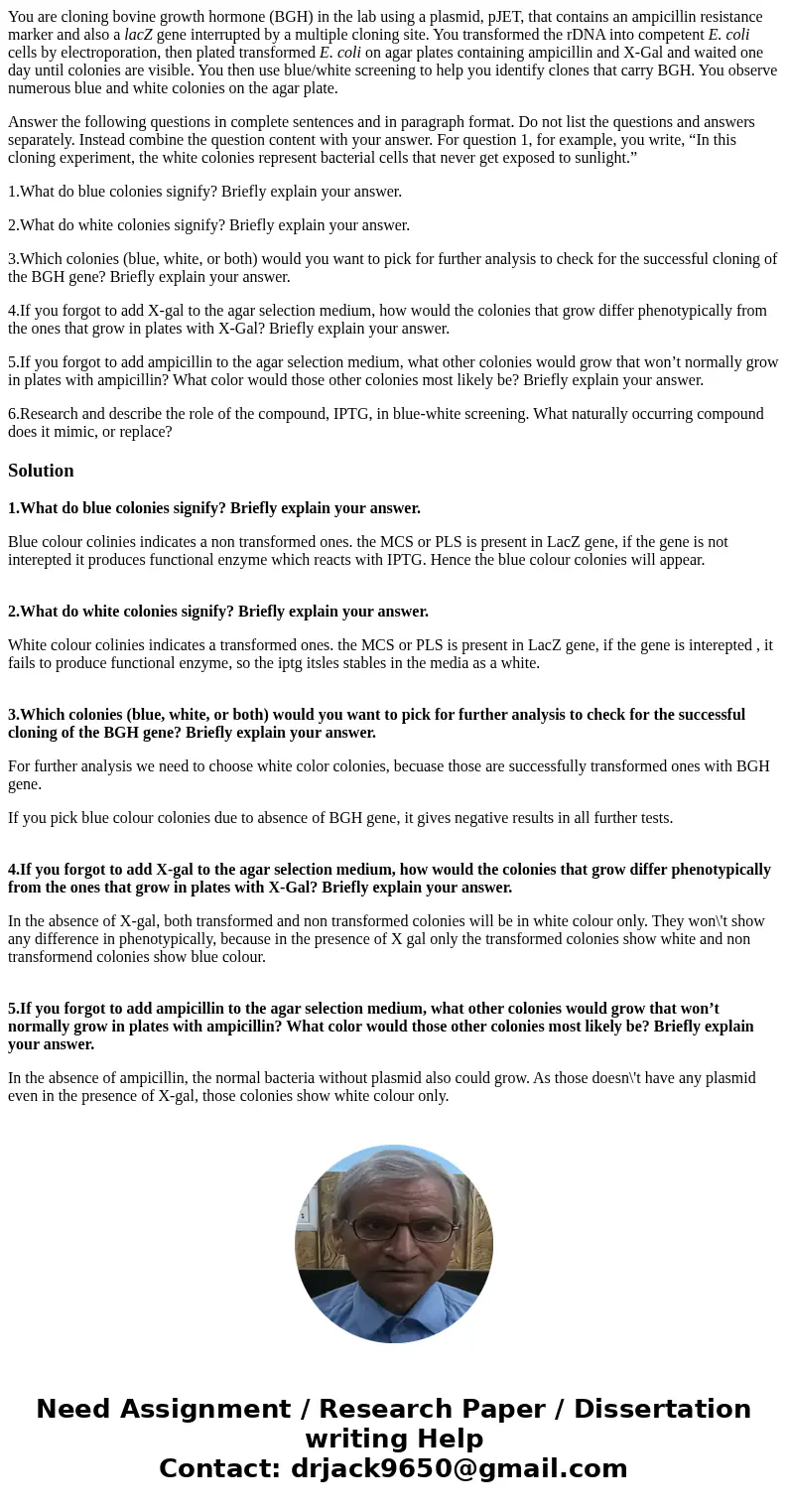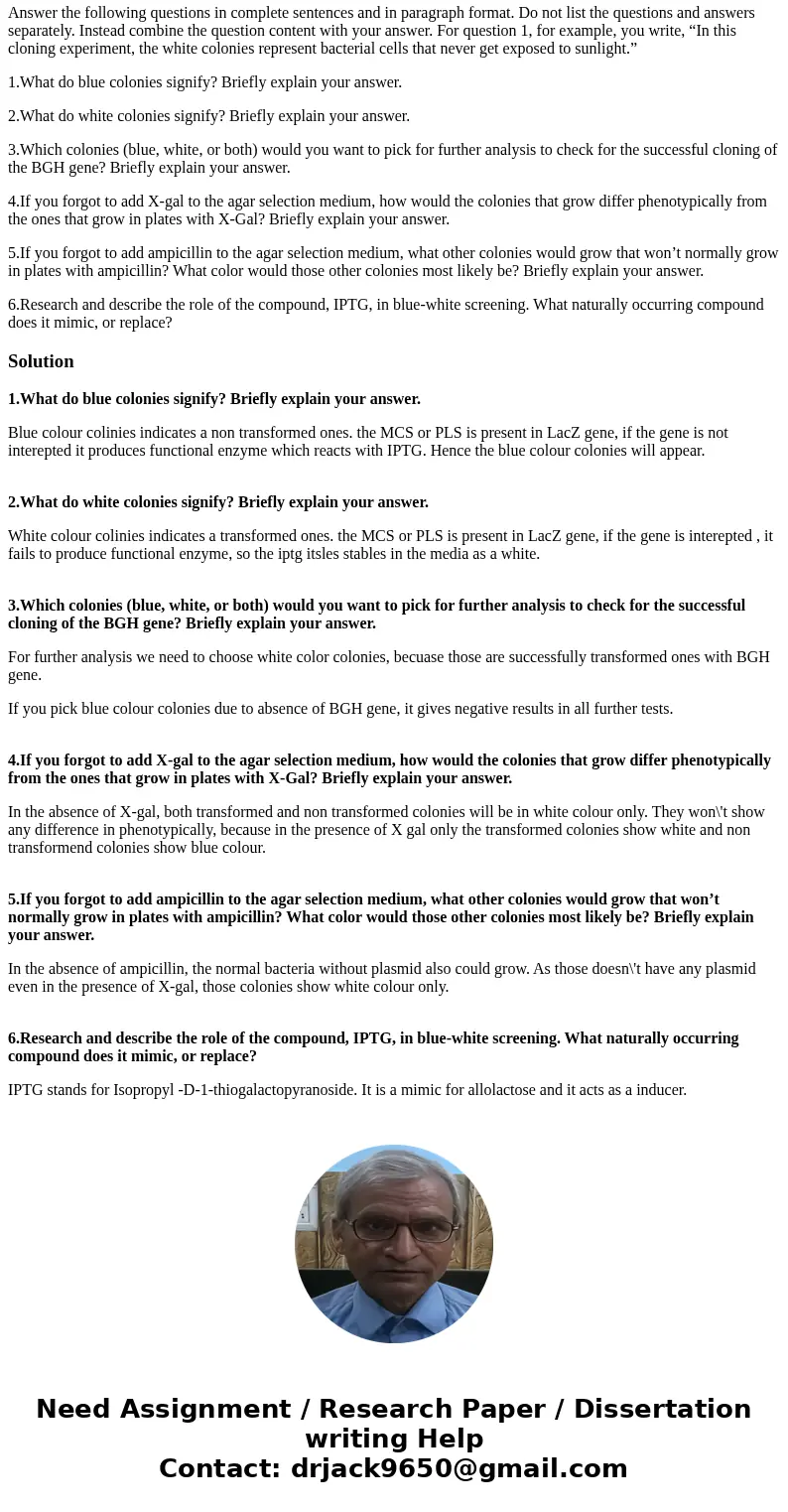You are cloning bovine growth hormone BGH in the lab using a
You are cloning bovine growth hormone (BGH) in the lab using a plasmid, pJET, that contains an ampicillin resistance marker and also a lacZ gene interrupted by a multiple cloning site. You transformed the rDNA into competent E. coli cells by electroporation, then plated transformed E. coli on agar plates containing ampicillin and X-Gal and waited one day until colonies are visible. You then use blue/white screening to help you identify clones that carry BGH. You observe numerous blue and white colonies on the agar plate.
Answer the following questions in complete sentences and in paragraph format. Do not list the questions and answers separately. Instead combine the question content with your answer. For question 1, for example, you write, “In this cloning experiment, the white colonies represent bacterial cells that never get exposed to sunlight.”
1.What do blue colonies signify? Briefly explain your answer.
2.What do white colonies signify? Briefly explain your answer.
3.Which colonies (blue, white, or both) would you want to pick for further analysis to check for the successful cloning of the BGH gene? Briefly explain your answer.
4.If you forgot to add X-gal to the agar selection medium, how would the colonies that grow differ phenotypically from the ones that grow in plates with X-Gal? Briefly explain your answer.
5.If you forgot to add ampicillin to the agar selection medium, what other colonies would grow that won’t normally grow in plates with ampicillin? What color would those other colonies most likely be? Briefly explain your answer.
6.Research and describe the role of the compound, IPTG, in blue-white screening. What naturally occurring compound does it mimic, or replace?
Solution
1.What do blue colonies signify? Briefly explain your answer.
Blue colour colinies indicates a non transformed ones. the MCS or PLS is present in LacZ gene, if the gene is not interepted it produces functional enzyme which reacts with IPTG. Hence the blue colour colonies will appear.
2.What do white colonies signify? Briefly explain your answer.
White colour colinies indicates a transformed ones. the MCS or PLS is present in LacZ gene, if the gene is interepted , it fails to produce functional enzyme, so the iptg itsles stables in the media as a white.
3.Which colonies (blue, white, or both) would you want to pick for further analysis to check for the successful cloning of the BGH gene? Briefly explain your answer.
For further analysis we need to choose white color colonies, becuase those are successfully transformed ones with BGH gene.
If you pick blue colour colonies due to absence of BGH gene, it gives negative results in all further tests.
4.If you forgot to add X-gal to the agar selection medium, how would the colonies that grow differ phenotypically from the ones that grow in plates with X-Gal? Briefly explain your answer.
In the absence of X-gal, both transformed and non transformed colonies will be in white colour only. They won\'t show any difference in phenotypically, because in the presence of X gal only the transformed colonies show white and non transformend colonies show blue colour.
5.If you forgot to add ampicillin to the agar selection medium, what other colonies would grow that won’t normally grow in plates with ampicillin? What color would those other colonies most likely be? Briefly explain your answer.
In the absence of ampicillin, the normal bacteria without plasmid also could grow. As those doesn\'t have any plasmid even in the presence of X-gal, those colonies show white colour only.
6.Research and describe the role of the compound, IPTG, in blue-white screening. What naturally occurring compound does it mimic, or replace?
IPTG stands for Isopropyl -D-1-thiogalactopyranoside. It is a mimic for allolactose and it acts as a inducer.


 Homework Sourse
Homework Sourse